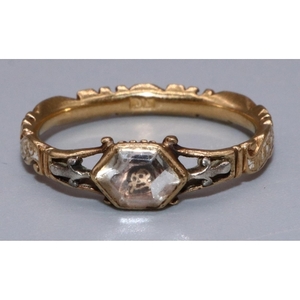News
Memento Mori: Remember You Must Die
Posted On: 05 Dec 2023 by Jodie Merritt to Object In Focus: Memento MoriMemento Mori mourning jewellery is a fascinating insight into attitudes to death and the afterlife - and at Ryedale Auctioneers, we are thrilled at the chance to work with a piece ahead of this weeks Country House sale!

Memento Mori: Remember You Must Die
Lot 1004 in last week's Country House Sale is this beautiful and haunting Georgian mourning or 'memento mori' ring, designed to commemorate the loss of a loved one. Mourning jewellery dates back to the 1600s, and was popular through the 1700s and 1800s, particularly after Queen Victorian mourned the death of her beloved Albert. This ring is earlier than that, dedicated to Mary Denham, who died in 1741, aged 29.
The ring is crafted from unmarked yellow metal and white enamel, and set with hexagonal rock crystals above a symbolic skull motif (other popular motifs for Georgian mourning jewellery included skeletons, gravediggers and coffins). The mourning jewellery of this time w as designed as a ‘memento mori’ (reminder of death’s inevitability). This reminded people to live life to the full. Memento Mori—Latin for “remember you must die”—is an ancient practice of reflecting on mortality and appreciating the brevity of life.
What Is Memento Mori?
Memento Mori is a philosophical concept that encourages us to take life's experiences seriously and be mindful of death. This ancient practice encourages us to appreciate the beauty of life, while being aware that our time on this earth is finite. The phrase itself has multiple interpretations—from an acceptance of death as a part of life to an appreciation for its fragility.
This is a practice that has been explored by many cultures throughout history, from the Ancient Greeks to the Catholic Church. It has been used as a way to practice mindfulness and appreciate the beauty of life, while also reminding us that death is inevitable. In the Middle Ages, it was often depicted in art—from paintings to sculptures—as a reminder of mortality and a message to enjoy life. In modern times, it has been used to encourage people to make the most of every moment.
The Spirit of Memento Mori
Memento Mori is not meant to be morbid or depressing. It is a reminder to live each day with intention and appreciation for life's moments. By embracing mortality, we can recognize the importance of living life to the fullest and taking advantage of every opportunity. This ancient practice encourages us to appreciate what we have, rather than obsessing over what we don't have, and to live life with purpose.
Ultimately, this is a reminder that life is precious and fleeting, and it encourages us to appreciate every moment. It is a way to practice mindfulness and be present in the here and now, while also being aware of our mortality. By reflecting on death, we can better appreciate life's moments and make the most of our time here on Earth.

How Is Memento Mori Expressed?
The expression of this concept takes a number of forms, and can be found in a variety of mediums. In literature, it might appear as a reminder to be mindful of time—“time waits for no man”, and “gather ye rosebuds while ye may” are popular expressions, and novels and poems such as The Picture of Dorian Gray explore the idea.
Art typically depicts the concept with paintings known as "vanitas" - these are compositions that contain elements of mortality, such as skulls, wilting flowers, and hourglasses. Sculptures and monuments often feature a figure with a skull at their feet to remind viewers of death. Jewellery is another popular medium - many people wear rings or necklaces with the phrase “memento mori” inscribed on them as a reminder of mortality, or pick jewellery that features images of death such as skulls or hourglasses and may form part of "mourning jewellery", designed to commemorate the loss of a loved one.
Conclusion
Memento Mori is a powerful reminder to live life to the fullest and appreciate its beauty. By reflecting on our mortality, we can be more mindful of our experiences and savour each moment. It is a reminder to make the most of every day, and recognize that death is part of life - a concept that only enhances the beauty for those left behind.

